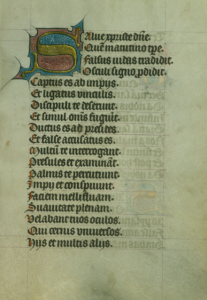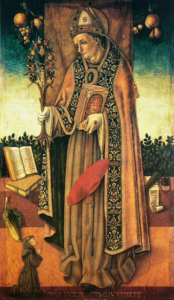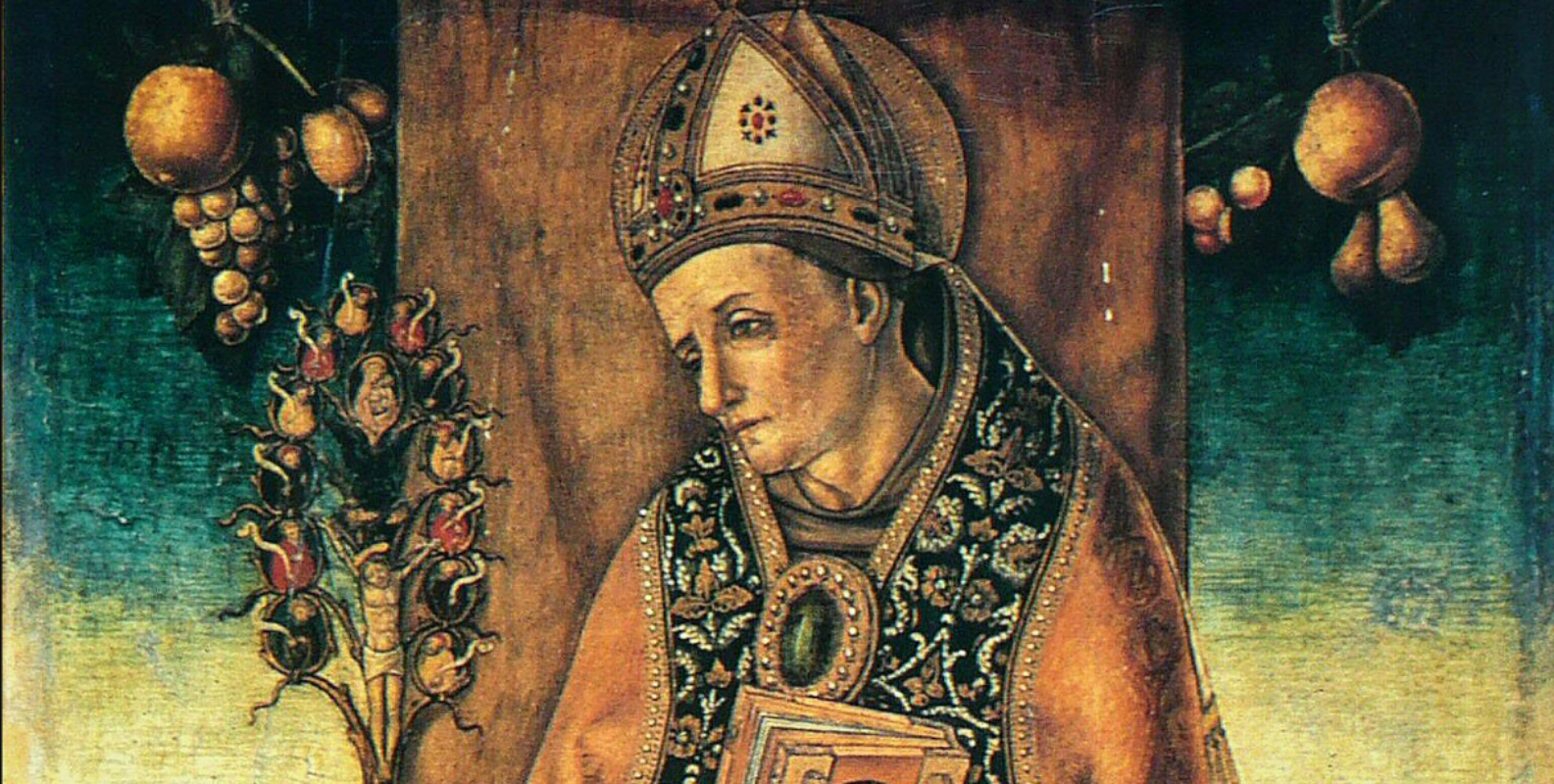The Walters MS W.172 of the Walters Art Museum in Baltimore, Maryland, is a seemingly average Book of Hours at first glance. Most Books of Hours we’ve looked at for this class have used the white space of the parchment to its fullest, wasting as little precious space as possible. Much of the core text tends to be written in dense blocks of prose, save calendars, and most of W.172 is no different. That is, until, you come to 52r. Here we have a poem in true lines, and one that rhymes at that! (Side note: to see other portions of W.172 that also have a significant amount of white space, see Katie and Mikaela’s earlier blog post.)

The Digital Walters website lists the contents of 52r-58r as a “devotional sequence beginning with Hours of the Cross with rhyming and short lines, Matins followed by verse prayer to Christ.” That’s an accurate but deceptively simple way to put it. Even with my very, very limited Latin, I could tell it was an Hours of the Cross by its clearly rubricated hours. The Hours of the Cross is, like the Hours of the Virgin, a set of prayers meant to be recited at the canonical hours (Matins, Laudes, etc.). Instead of following the life of the Virgin Mary, however, the Hours of the Cross follow the events of Christ’s Passion, beginning with his betrayal by Judas. The Hours of the Cross is also usually shorter than the Hours of the Virgin. Here, the entirety of our Hours of the Cross, with all its canonical hours, is written as a poem.
But where did it come from? And who wrote it? Reader, this section would prove to be a bit of a bugbear. For this blog post, I’ve decided to focus in on the first two hours of the poem, Matins and Prime.* In these hours, Christ is betrayed, mocked, and then finally judged before Pilate.
Verse Hours of the Cross are not as common as prose-style Hours of the Cross, but they are not rare. I thought I would be able to find a version of this poem elsewhere, or at least one very similar to it; but after a lot of searching, I could still find no verbatim correlations to the verse in Latin–not through Google, journal databases, or otherwise. I had already transcribed several other sections of W.172, and their contents had all been very “findable,” as they are mostly common hymns and Psalms. But this Hours of the Cross verse is anything but common. Though I encountered other verse Hours of the Cross in my search, this poem has unique qualities that set it apart. It follows a rhyme scheme and is a second person, present perfect address to Christ: “You are lead to the guards / And you are falsely accused.” It’s a deeply personal meditation in which the reader is speaking directly to Christ. The verse itself is perhaps original, or at least has not been well-documented elsewhere. And while it still follows the fairly traditional narrative structure of Christ’s Passion, a few details struck me as more specific than a general Passion story.

The line that stood out to me most was “Ad herodem mitteris,” which translates to “You are sent to Herod.”** Herod had not shown up in the Gospel accounts I’d previously seen in Books of Hours. Herod’s appearance firmly places this Hours of the Cross as being based on the Gospel of Luke, specifically Luke 23. Luke is the only one of the Gospels to feature the story of Pilate sending Jesus before Herod. (This is Herod Antipas and not his more infamous father, Herod the Great, who ordered the execution of male Jewish children.) This felt at first like a bit of dead end, as I couldn’t find an Hours of the Cross that was Luke-specific, and very few Books of Hours mention Herod at all.
From there, I decided to look at Medieval Latin religious poetry in general. In all my reading, one name kept popping up: St. Bonaventure. And moreover, he’d written what is referred to as an Hours of the Cross in verse, titled “Laudismus de Sancte Cruce,” and a book of prose, Commentary on the Gospel of St Luke.
Bonaventure’s life predated W.172 by some 200 years, but his poetry and prose were so influential as to spawn a whole genre of ‘psuedo-Bonaventure’ writings. His work focused heavily on Christ’s suffering on the cross, and he was known for his lively, affective style. There’s some speculation about attribution, but F.J.E. Raby writes: “Whether the hymns and poems which have been attributed to Bonaventura are really his or no, they breathe the ardent mysticism and the love of the Crucified which inflame every page of his prose writings.”
It turns out that many of Bonaventure’s prose works focused specifically (and solely) on the book of Luke, the largest being his Commentary. While it reads as more of a critical study than his poetry, it hits all the narrative points described in the W.172 poem. It seems Luke was Bonaventure’s preferred Gospel, with its extra narrative of Christ being being shamed before Herod.
Upon Jesus being sent before Herod, the W.172 verse Hours of the Cross reads: “You appeared a fool to that man / You who are the commander of the heavens.” Bonaventure’s Commentary spends a lot of time meditating on Herod’s foolishness in not seeing Christ’s true power. He dedicates several pages to examining the precise nature of Herod’s unworthiness before Christ. In the same scene, however, the Vulgate does not make such an explicit judgement of Herod (though it is implied). It does not mention Herod’s judgement of Christ nor Christ’s holiness, but rather documents this moment in a strict narrative. The verse Hours of the Cross chooses to diverge from the Vulgate story in order to reflect on the scene in way that is reminiscent Bonaventure’s work.

As Emily noted in her blog post, W.172 was made for/by the Windesheim Canons, a religious order that placed a particular emphasis on Christ’s emotional and bodily suffering. Given that shared focus of meditation, it seems likely that the Windesheim congregations would have been familiar with Bonaventure-style work, if not Bonaventure’s work itself.
The influential writer and theologian Thomas À Kempis, a member of the Congregation of Windesheim, was alive and publishing around the time of W.172’s production. Kempis’s book The Imitation of Christ is similar enough in style and content to Bonaventure that it had been misattributed to him on occasion. It’s also worth noting that when Kempis recounted the tale of Christ’s Passion in his Prayers and Meditations on the Life of Christ, he chose to reference Luke’s Passion. This suggests that there was at least some familiarity amongst Windesheim writers with the literary heritage of Bonaventure.
In reading Bonaventure’s prose and poetry alongside the W.172 Hours of the Cross, I noticed similarities and differences. Like the W.172 Hours of the Cross, “Laudismus de Sancte Cruce” (“In Praise of the Sacred Cross”) also uses a second person address, but it is directed toward the reader rather than Christ. It also makes use of rhyming couplets, though does not rely solely on them. The W.172 Hours of the Cross verse, however, is composed entirely of rhyming couplets. In terms of style, they bear a lot of similarity, as both are an exaltation of Christ’s sacrifice and his endurance through the Passion.
“Laudismus” is unusual for an Hours of the Cross, in that it does not list the hours and their specific meditations at all, simply stating: “Seven times, from early morning, Prime, Matins, Terce, Sext, and vespers, Ninth, and last, when you retire.” It is highly lyrical and focuses less on the events of the Passion than the reader’s contrition. The Hours of the Cross verse in W.172, however, tells the story of Christ’s Passion in a fairly straightforward but simplified manner, choosing instead to read like a poetic interpretation of Luke 23. Lines like “The wicked spit upon / Your mellifluous figure” bridge a gap between a strictly narrative style and a poetic style.
These stylistic and narrative similarities lead me to believe that the author of the W.172 poem, if not familiar with these particular examples of Bonaventure’s work, would have been familiar with any number of Psuedo-Bonaventure writings that expand upon the Gospel of Luke; and that the poem is (as with Mikaela’s and Katie’s prayers) a kind of collage, an intertextual rendition of Bonaventure’s poetry and prose.
* Hours of the Cross, unlike the Hours of the Virgin, traditionally skip Lauds.
** Many thanks to Dr. Camp for her helpful translations.
Works Cited
The Bible. Biblia Sacra Vulgata (Vulgate), https://www.biblegateway.com/passage/?search=Luke%2023%2CLucas%2023&version=KJV;VULGATE
Bonaventure, Saint, Cardinal. Commentary on the Gospel of Luke Part 3, Chapters 17 – 24 /. Franciscan Institute Publications, https://galileo-usg-uga-primo.hosted.exlibrisgroup.com/primo-explore/openurl?u.ignore_date_coverage=true&rft.mms_id=9913747022402931&vid=UGA&institution=UGA&url_ctx_val=&url_ctx_fmt=null&isSerivcesPage=true&lang=en_US
Bonaventure, Saint, Cardinal. “In Praise of the Sacred Cross.” Hartford Quarterly 4 no 4 (Summer 1964), 5-13. Translated from the Latin by David H. Graham, https://www.lrcatholic.org/pdf/bonaventure/InPraiseoftheSacredCross-Bonaventure.pdf
The Editors of Encyclopaedia Brittanica. “Thomas À Kempis.” Encyclopædia Britannica, Encyclopædia Britannica, Inc., https://www.britannica.com/biography/Thomas-a-Kempis
Jay Magill, R. “Turn Away the World: How a Curious Fifteenth-Century Spiritual Guidebook Shaped the Contours of the Reformation and Taught Readers to Turn Inward.” Christianity & Literature, vol. 67, no. 1, Dec. 2017, pp. 34–49, http://journals.sagepub.com/doi/full/10.1177/0148333117731587
Kempis, Thomas À. Prayers and Meditations on the Life of Christ. Translated by Michael Joseph Pohl and William Duthoit, Kegan Paul, Trench, Trübner & Company, 1908. Archive.org, https://archive.org/details/PrayersMeditationsLifeChrist/page/n111
Raby, F. J. E. A History of Christian-Latin Poetry From the Beginnings to the Close of the Middle Ages. Vol. Special ed. : 1997, Oxford University Press, 1997. EBSCOhost, proxy-remote.galib.uga.edu/login?url=http://search.ebscohost.com/login.aspx?direct=true&db=nlebk&AN=23033&site=eds-live
Image of Bonaventure: Vittore Crivelli [Public domain], via Wikimedia Commons, https://commons.wikimedia.org/wiki/File:Vittore_Crivelli_-_Saint_Bonaventure.jpg
